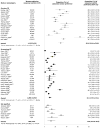Women's preference for caesarean section: a systematic review and meta-analysis of observational studies
- PMID: 21134103
- PMCID: PMC3312015
- DOI: 10.1111/j.1471-0528.2010.02793.x
Women's preference for caesarean section: a systematic review and meta-analysis of observational studies
Abstract
Background: The striking increase in caesarean section rates in middle- and high-income countries has been partly attributed to maternal request. We conducted a systematic review and meta-analysis of women's preferences for caesarean section.
Objectives: To review the published literature on women's preferences for caesarean section.
Search strategy: A systematic search of MEDLINE, EMBASE, LILACS and PsychINFO was performed. References of all included articles were examined.
Selection criteria: We included studies that quantitatively evaluated women's preferences for caesarean section in any country. We excluded articles assessing health providers' preferences and qualitative studies.
Data collection and analysis: Two reviewers independently screened abstracts of all identified citations, selected potentially eligible studies, and assessed their full-text versions. We conducted a meta-analysis of proportions, and a meta-regression analysis to determine variables significantly associated with caesarean section preference.
Main results: Thirty-eight studies were included (n = 19,403). The overall pooled preference for caesarean section was 15.6% (95% CI 12.5-18.9). Higher preference for caesarean section was reported in women with a previous caesarean section versus women without a previous caesarean section (29.4%; 95% CI 24.4-34.8 versus 10.1%; 95% CI 7.5-13.1), and those living in a middle-income country versus a high-income country (22.1%; 95% CI 17.6-26.9 versus 11.8%; 95% CI 8.9-15.1).
Authors' conclusions: Only a minority of women in a wide variety of countries expressed a preference for caesarean delivery. Further research is needed to better estimate the contribution of women's demand to the rising caesarean section rates.
© 2010 The Authors Journal compilation © RCOG 2010 BJOG An International Journal of Obstetrics and Gynaecology.
Conflict of interest statement
All authors declare that there are not conflicts of interest.
Figures
References
-
- Arias E, MacDorman M, Strobino D, Guyer B. Annual summary of vital statistics 2002. Pediatrics. 2003;112:1215–30. - PubMed
-
- Belizan JM, Althabe F, Cafferata ML. Health consequences of the increasing caesarean section rates. Epidemiology. 2007;18:485–6. - PubMed
-
- Althabe F, Sosa C, Belizán JM, Gibbons L, Jacquerioz F, Bergel E. Cesarean section rates and maternal and neonatal mortality in low-, medium-, and high-income countries: an ecological study. Birth. 2006;33(4):270–7. - PubMed
-
- Betrán AP, Merialdi M, Lauer JA, Bing-Shun W, Thomas J, Van Look P, Wagner M. Rates of caesarean section: analysis of global, regional and national estimates. Paediatr Perinat Epidemiol. 2007;21(2):98–113. - PubMed
Publication types
MeSH terms
Grants and funding
LinkOut - more resources
Full Text Sources
Medical



